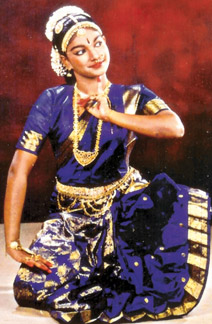Bharatha Natyam and Tamil culture
Subashini Pathmanathan
The folk dance form is regarded as Desi dance form, because it
belongs to a certain Pradesh. It reflects religion, regional customs and
traditions of the selective area. These folk dance forms differ from
region to region, place to place, and district to district. Hence the
folk dance varies from place to place.
 |
|
Pristine
purity of dancing movements |
Similarly a dance form which transcends the international barriers
acquires worldwide recognition, which is known as Margi. This Margi
dance form is deeply rooted in culture, tradition, philosophy, and
religion. Bharatha Natyam is certainly a Margi dance form.
It has a well refined and highly sophisticated art form. Bharatha
Natyam is a Tamil Classical dance form based on Hindu philosophy, Hindu
traditions and Hindu culture. Besides, Bharatha Natyam is totally based
on the Tamil Language, yet some of the Kirthanams, songs, surajathi and
Varnam items are in Telugu language, because until the year 1953, Madras
presidency and Andhra state were together. Surajathi was only in
Carnatic music but not included in the Bharatha Natyam. But now, some
dancers adopt Surajathi for dance.
Bharatha Natyam is the classical dance form of the Tamils. It has its
own grace, charm and standing in the international sphere. Wherever
Bharatha Natyam is practised, it is expected to remain the same quality
and norms.
This particular art form is not only followed and practised in India
alone, but also preserved and practised by the expatriate Tamil
community all over the world. Bharatha Natyam is often referred as
‘Bharatham’. This word is derived from the Tamil word ‘bavam’, ‘ragam’,
and ‘Thalam'.
Traditional dance forms in any society must have certain norms and
defined links with cultural, linguistic, regional and religious factors.
These traditional dance forms generally have certain long-standing
historical background and historical developments in different periods.
Almost every traditional cultural dance form is systematically
categorized into different steps, different hand gestures, eye movements
neck movements and different names for different foot positions, and
different foot movements. Each traditional dance form has some deep
meaning. Traditional dancers vehemently stick within a certain limited
framework.
It is not proper or possible to expect that in the modern era a
certain modification could be done in the classical Bharatha Natyam.
Every classical art form has its own well defined concepts. Inserting
their own techniques by claiming some false allegations by certain
individual dancers and dance teachers cannot be accepted. All these
tactics are done in the present era to attract the maximum amount of
audience.
Bharatha Natyam is basically a solo dance form. But now only it has
become a group dance form. The main reason behind this is to accommodate
more performers together on the stage.
Bharatha Natyam is often regarded as the state classical dance of
Tamil Nadu. However the Tamils all over the world preserve and practice,
and carry out this art form with deep devotion and dedication as their
own asset.
Even some of the traditional dance forms like Russian Ballet, western
dance forms, Eastern dance forms, South American dances, Far East Asian
dance forms, and South East Asian dance forms, are systematically
confined and defined dance techniques. Each traditional form has its own
distinguish makeup, stage decorations, distinguish costumes and
selective ornaments. Most ornaments have certain names as well as
certain significance for the purpose of usefulness.
At the end of the last quarter of the 20th century, generally a new
trend has been penetrated into almost all the classical dance forms. The
trend has developed by so called modern dance choreographers. They
insert their numerous own ideas, and they introduce their own creativity
into these dances. Besides they borrow techniques from numerous other
traditional dance forms. They mainly borrow the nuances, techniques,
steps, costumes, ornaments, and makeup from various, other traditional
dance forms.
|



